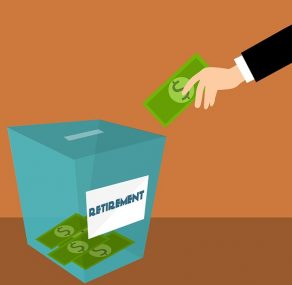Articles
All the latest articles covering the information that you will be craving to devour will be available via this category. From getting to know how indebted our company is to reading about the presidential elections; from knowing about new retirement plans to finding out how security breaches can affect your life; you can browse it all!
For more articles, visit our articles’ section.
Public Sector Retirement, LLC (‘PSR,’ ‘PSRetirement.com’ or the ‘Site’) is a news channel focusing on federal and postal retirement information. Although PSR publishes information believed to be accurate and from authors that have proclaimed themselves as experts in their given field of endeavor but PSR cannot guarantee the accuracy of any such information not can PSR independently verify such professional claims for accuracy. Expressly, PSR disclaims any liability for any inaccuracies written by authors on the Site, makes no claims to the validity of such information. By reading any information provided by June Kirby or other Authors you acknowledge that you have read and agree to be bound by the Terms of Use
401(k) and IRA Account Money: It Isn’t Entirely Yours
/by AdminWhen it comes to retirement, those with higher incomes might not be as prepared for retirement as they would like to think.
It can be concerning that those who are approaching retirement with IRA and 401(k) balances are not aware that their accumulations require taxes to be paid. It may be difficult to accept that the money that one has worked so hard for in an account that they have contributed to throughout their working years does not all belong to them.
There have been definite benefits throughout the years of not being mandated to pay taxes on contributions paid into IRA and 401(k) plan accounts and on investment returns on the same contributions. A little calculation reveals that deferring taxes for a long time can have real, true value. The benefit is equal to exempting taxation from investment returns on plan assets. So even after paid taxes on withdrawals, one is still ahead.
The issue isn’t whether or not the tax treatment accorded is a good deal. It really is, especially for high-income people who benefit the most. The concern comes in for people with moderate and higher incomes who haven’t assessed how well prepared they are for retirement.
The key point of this discussion is to remind those of us who are aware of the benefits of retirement savings and to alert those who are unaware. In fact, if you are unsure of how well-prepared you may be for retirement, or if you have money saved up in a plan like a 401K IRA, then it is highly advised to start acting now. A qualified financial advisor can help provide guidance and possibly even help you answer questions that you haven’t even thought of yet.

Understanding Short-Term Disability
/by AdminShort-term disability is, by the government’s definition, a mental or physical condition that renders one unable to do their job for any period that is less than a year. Unfortunately, many employees aren’t offered programs that cover such situations. If you do have disability options, then be thankful that these exist for you to fall back on.
Leave Transfer Program
If you must take an extended leave without pay, fellow employees may ease your financial burden by donating their annual leave to you. You would be paid at your usual hourly rate of pay until the donated leave ends, or until the medical emergency ends.
Workers Compensation
You may be eligible for workers compensation if your disability was due to a disease or personal injury occurring while performing your job. Workers compensation payments begin when your leave runs out.
Paid Leave
Every pay period, employees earn both annual and sick leave. You can use your accumulated sick leave if you have short-term disability. If the sick leave runs out, you can use any accrued annual leave that you have saved up. Your current supervisor may have the authority to advance both your annual and sick leave in the case that both your accumulated sick and annual leave has run out. The maximum amount of advanced sick leave that you can receive is 104 hours, and even less when you work part-time.
Leave Without Pay
If you have depleted your sick and annual leave, and the advanced ones granted by your supervisor, or your supervisor doesn’t have the authority to grant any advanced leaves, he or she might be able to grant you periods of leave without pay. Your supervisor might even be able to do that before you exhaust your annual or sick leave. This is if the agency policy allows it.
Disability Retirement
You could file for disability retirement if you have at least 18 months of service under FERS and, most importantly, if your disability is expected to last a year or longer. By definition, CSRS employees already have the five years of service needed to qualify for disability retirement.
While these alternatives are not necessarily well-designed in the event of short-term disability, at least these options are available.

Maximizing Your Tax Returns in 2019
/by AdminThe clock is ticking away when it comes to the various ways Americans can keep their hard-earned money in their pockets with April 15 being the tax deadline. Taxpayers tend to leave too much tax return money on the table, and this problem mostly occurs because they haven’t known about (or taken) all of the deductions and breaks that were permitted.
A research paper by the University of California notes that every year Americans pay roughly $1.5 trillion income taxes. That’s a really big number in which approximately 8.3% of U.S gross domestic product goes straight from taxpayers’ bank account into the U.S Treasury.
In addition, the report states that American taxpayers have a routine of selling themselves short on their tax returns and walking away from the money they could have saved. This has been seen especially in key areas claiming U.S government tax deductions and benefits and retirement savings.
All this boils down to the tax breaks, in the form of tax credits and tax deductions as you prepare to save money on your taxes this year it is important to understand the difference between the two tax breaks. Tax credit – this directly slashes your Tax bill to Uncle Sam it’s dollar for dollar cut on your tax bill. Tax deduction- this lowers the amount of income IRS can tax. A good example of a common tax deduction available to U.S. taxpayers is the standard deduction.
Simply, tax deductions are subtracted off the amount of taxable income you earn. It’s possible to overpay the IRS and in that case, get a refund, but that’s if you can stack up enough to overpay tax deductions.
These 10 tax breaks to get you your fair share:
1. Student loan interest deduction allows U.S. families to deduct interest paid on student loans. The amount can be up to $2,500.
2. American opportunity tax credit allows college households to claim $2,000 in federal tax deductions on assorted college costs like fees, textbooks, tuition, and meal plans. An additional 25% can be claimed by qualified taxpayers of %2,000 more paid out in college costs.
3. Child and dependent care credit allow households to claim a deduction of up to $3,000on daycare costs for kids that are under 13 years; this is also applicable for senior parents, dependent or an incapacitated spouse. The amount can double up to $6,000 for two or more family dependents.
4. Child tax credit provides a tax break of up to $2,000 for parents and $500 for a non-child dependent.
5. Earned income tax provides up to $6,431 in tax deductions depending on the amount of income and number of children in a household.
6. Charitable donation tax break is available to taxpayers who itemize their deductions and also enables taxpayers to deduct charitable donations from their taxes.
7. Medical expenses tax deduction allows taxpayers to claim medical costs exceeding 7.5% that is unreimbursed of the tax payer’s adjusted gross income over a year.
8. State and local deductions allow taxpayers to claim up to $10,000 In tax deductions for a combo of local and state taxes. This including property taxes.
9. Retirement plan tax deductions allow up to $18,500 into a self-employed or company sponsored 401(k) plans. Depending on your income status deductions on individual retirement accounts are available.
10. Health savings account tax break – with this health savings accounts up to $3,450 for individual contributions and $6,900 for family-level contributions.
If needed, work with a specialist to enable you to save the most money possible on your tax returns this year.

How to Start on the Retirement Process
/by AdminIt is recommended that one should begin planning for retirement at the very least a year ahead of the expected retirement day. However, a RIF or an early retirement offer can help you make a quick decision on matters regarding retirement. Either way, it is advised to use the time you have wisely to plan ahead.
If the agency you are working with offers a seminar on pre-retirement counseling, it may be best to take it seriously. If your agency doesn’t offer such seminars, do consider attending one offered by a firm in the private sector. Your agency may even pay for it in some cases.
To make sure that your official personnel documents cover all your federal employment, get in touch with your agency’s benefits counselor and go through your folder. Also, go through the effective dates of each pay adjustment, life insurance coverage, and your present health benefits. The two of you can straighten out anything that is inaccurate or missing.
Go ahead and verify when you’ll meet the age and service requirements to retire if your OPF is updated and accurate. Also, ensure that you meet the requirements needed to carry your life insurance coverage and health benefits into retirement.
Ask for an estimate of your annuity retirement; you’ll also need an estimate of your special retirement supplement (that is if you are a FERS employee). You need to find out how your annuity can be affected if you are currently receiving military retired pay. It’s a rule that you have to waive your military retired pay and make a deposit before retirement for that time to be included in the calculation for your civilian annuity. On rare occasions, you might receive both, but even then, a deposit needs to be made so as to get credit for that time. Filling out your retirement application is the last step, and if everything checks out you’ll be well on your way to retire on the day you have chosen!

Retirement Funds vs Emergency Fund
/by AdminYou may end up frustrated at the low return on your investments if you choose to save your money in an emergency fund. Don’t be; this rainy day money is meant to be ready and accessible in the event of a storm.
A certified financial planner helped answer some important questions on if you should pull out retirement money to pay off consumer debt, as well as where to park your emergency fund.
Question 1: At the age of 65 and recently retired from federal service, what should be done when it comes to the Thrift Savings Plan? What happens in the event that there is a large sum of tax and consumer debt?
Answer: There would be a huge tax bill withdrawing all your TSP at once. It’s important to figure out how much can be taken out each year in a low tax bracket. Consider working with an hourly financial planner or an accountant to do this. Also, create a plan to pay off the debt using your current funds and the small amounts you can take out of the TSP over time.
Question 2: As a retired federal employee in the late 60s with a spouse turning 71, what can be done about a larger home that is no longer age-friendly?
Answer: It is important to figure this out sooner rather than later if your house can be made age-friendly. Consider talking to an hourly financial planner to help you determine the cost of your options and see if you have the resources to meet them.
Question 3: Let’s say that there is $75,000 in a money market account for emergencies, like a layoff, for example. Does it make sense to make $65,000 work harder in a year and leave $10,000 in the money market for fluidity’s sake?
Answer: For one year, that is a good rate. However, be sure to have at least one month of expenses in the liquid money market to avoid getting hit with penalties if you need to tap some of that money.
Overall, the best way to make sure you are making the right decision when it comes to what should be done with your retirement funds is to reach out to a financial planner and work with them directly.

Are You Ready for the New Federal Income Tax Form?
/by AdminThe number of various major changes under the new tax law may make your 2018 federal income tax return unlike anything you’ve seen in the past. The first proper steps can help you fight anxiety and tackle your taxes. The earliest IRS will accept returns is Jan 28, seeing as the deadline is April 15.
Pick up a copy of last year’s tax return. The tax rules have dramatically changed, and there’s a 1040 form with a new look. The old return for the 2017 tax year can be a road map for making sure you have gathered all the paperwork you need to file your 2018 tax return.
An old 1040 may remind you that you don’t have a 1099-INT from a bank account or the latest 1099-DIV from a mutual fund to report dividends and capital gains.
Find valid social security numbers; IDs ensure that you have the accurate social security numbers for you, your spouse and your children as well. If you had a baby in 2018, you would need the newborn’s social security number for your tax return. Some tax preparers for some form of identification to prove who you say you are. You can make it a point of carrying your drivers license or state identification number. In addition, some states will reject an e file on a state return if you don’t submit information from a state ID or driver’s license.
See if you can file for free. The IRS site offers a program that allows taxpayers access to brand-name tax products, free of charge, to prepare a federal tax return and file it for free, depending on their income. The program has reportedly been made more consumer-friendly to chop off some outside marketing efforts. H&R Block also offers its free file program via the IRS site to those between the ages of 17 and 51 and with an adjusted gross income of $66,000. In addition, H&R Block offers free file of a state return if you qualify for the federal return.
Take time to review a checklist. You might receive a checklist via email or in the mail if you are working with a tax professional. Sites such as H&R Block also provide a checklist that can easily be used by anyone to help them figure out what information they need to complete a tax return. If you currently reside in the United States and need a replacement form SSA-1099 or SSA1042S, the Social Security Administration (SSA) allows you to go online and get an instant, printable replacement form with a My Social Security account.
Know your bank account. If you would like your tax refund directly deposited into your account, it would be wise to triple-check your routing number and bank account number. A lot of tension can be avoided if you make sure to key in the correct number.
It may be possible to make the correction to your bank information before e-filing your tax return again. That is if the IRS rejects your return. By using direct deposit, you would get your refund faster. Additionally, direct deposit also helps avoid the chance of a tax refund check getting lost or returned to IRS because the post office said it could not be delivered. The IRS emphasizes to taxpayer’s that they should only deposit refunds directly to accounts that are their own; in their name, their spouse’s name, or both if it’s a joint account.

Difference between CSRS and FERS

TSP CSRS, or the Civil Service Retirement System, offers the Thrift Savings Plan as a supplement to your CSRS Annuity or military pay- as of January 1st, 2018, military employees also participate in a military TSP.
TSP and FERS, or Federal Employees’ Retirement System, makes your TSP one part of a three-part retirement plan. This also includes the FERS Basic Annuity and Social Security.
The difference between the FERS or CSRS Annuity and the TSP is that the annuity is based on your years of service, rather than how much you have contributed, and is also voluntary, as opposed to the annuity.
Regardless of which retirement system you qualify for, contributing to the Thrift Savings Plan is vital to your retirement, especially if you contribute early. TSP compound interest means that the earlier you start to make contributions, the better. However, if you did not start saving at an earlier point, committing to a steady and consistent contribution schedule will almost always produce positive results.
How does TSP work?
If you are a new federal employee, you most likely have an established account and were enrolled in a 3% payroll deduction. If you were hired before July 31st, 2010, you were not automatically enrolled in a TSP account and will need to create it yourself. For CSRS employees and members of the uniformed services, you must elect to contribute to the TSP. You are also not eligible for agency contributions.
You can elect to stop or change your contributions at any time. Check with your payroll office or agency to find out how to sign up for TSP. You may be required to use your agency or service’s electronic system, or you may have to submit Form TSP-1 (Form TSP-U-1 for uniformed services). The Thrift Savings Plan website has the forms available if your agency or service accepts them.


TSP funds
There are five core funds in the Thrift Savings Plan- four of them are index funds, which mean that they are exactly matched to a broad market index.
- G Fund (Government Securities Investment Fund)
- This fund does not invest in an index. The only fund that it is connected to is a nonmarketable treasury security issued for the TSP by the U.S. Lowest return and risk
- F Fund (Fixed Income Investment Index Fund)
- Matches the Barclays Capital U.S. Aggregate Bond Index. Slightly higher return and slightly higher risk.
- C Fund (Common Stock Index Investment Fund)
- Out of the three stock funds in the TSP, the C is considered the most conservative. It is connected to the Standard and Poor’s 500 Index, which has greater volatility than either the G or F funds.
- S Fund (Small Capitalization Stock Index Fund)
- This fund is connected to the Dow Jones U.S. Completion Total Stock Market Index, which is a total of 4,500 companies that fall outside of the S&P 500’s list. Potential for large growth, but also large losses.
- I Fund (International Stock Investment Fund)
- The only internationally invested fund. High risk, but potentially high reward.
There is another option for Thrift Savings Plan investment funds- the L funds. These are funds that actually invest in a variety of all the other funds and target a specific retirement date, initially investing in the more aggressive funds and slowly moving into the more stable bonds funds as retirement approaches.
How to change my TSP contribution
If you have not made a contribution election through your agency to start contributions or change the way your contributions work, there are a few steps:
- Ask your personnel or benefits office whether your agency or service handles enrollments
- Determine the amount you want to contribute and whether you want a Roth or Traditional TSP
- Return your completed TSP-1 or TSP-U-1 to your employer to get your payroll deductions set up. Your election should be effective no later than the first full pay period after your agency or service receives it.


Withdrawing from the TSP
You have several withdrawal options that you can choose from. Partial withdrawals are allowed in a single payment. You can also make a full withdrawal with any one or any combination of the following methods:
- A single (lump sum) payment
- A series of monthly payments
- A life annuity (Thrift Savings Plan Lifetime payment options).
A combination of any of these three full withdrawal options is called a “mixed withdrawal.” You can have the Thrift Savings Plan transfer all or part of any single payment or, in some cases, a series of monthly payments, to a traditional IRA or an eligible employer plan by completing the TSP-70 form. Payments to you can be deposited directly into your checking or savings account using electronic funds transfer (EFT).
Spouse’s Rights
If you are a married Thrift Savings Plan participant (even if you are separated from your spouse), spouses’ rights apply to annuity purchases. If you are a married FERS or uniformed services participant with a total account balance of more than $3,500 and you are making a full withdrawal of your account, your spouse is entitled by law to an annuity with a 50% survivor benefit, level payments, and no cash refund. If you choose any other withdrawal option or combination of options by which your entire account balance is not used to purchase this particular type of annuity, your spouse must sign the statement on your withdrawal form that waives his or her right to that annuity.

FEHB Modernization is OPM’s Goal
/by AdminContrasting different Federal Employee Health Benefits (FEHB) plans, and then enrolling in them, can be a daunting task, which is why the Office of Personnel and Management (OPM) is currently looking for vendors that can help set up a one-stop shop for all federal employees health care needs. Until February 15th, the RFI was open to inquiries, but March 11th is the date they are open until for responses.
This proposed portal would be used to find coverage for all current and retired federal employees and their families.
To put the need for modernization into perspective, the FEHB currently has 4 million people enrolled in it, with one million transactions each year. Premiums for the FEHB are over $54 billion.
Though the administration of FEHB is overseen by the OPM, things like enrollment and reconciliation, as well as most areas of benefactor’s services are spread out across different avenues in both the federal and private sectors. This complicates the process for most people who have enrolled and is more expensive to run on a technical and administrative level.
To rectify this, the Office of Personnel and Management is looking to streamline much of the current system, including enrollment processing and support, decision support, enrollment and premium reconciliation, and the warehousing and reporting of incoming data.
As the OPM has noted, the Central Enrollment Program (CEP) would be the ideal source for this data reporting, as they are able to show transactional data for all the insurance carriers and related agencies in the entirety of the FEHB.
The OPM is also looking for vendors who have an insight into AI capabilities that can administer multi-factor authentications and real-time data validations, while also giving employees the support and functionality they need.
The OPM is also looking into artificial intelligence that can figure out patterns in data and give an overview to authorized people enrolled in the program, while still complying with all the current regulations like the FISMA, FedRAMP, and NIST guidelines. As technology improves, so should the program.

Maximizing the Efficiency of Retirement Savings
/by AdminIn recent times, there has been a particular focus in the US on retirement security. While assessing potential solutions to the multi-employer pension plan financial crisis, policymakers are also considering a plan that would allow small businesses to offer group retirement plans with other small entities. In Canada too, the Canada Pension Plan is getting stronger thanks to a consultation from the federal government.
Though the various talks and discussions have had very different topics and policies in mind, they all seem to have one theme; maximizing the efficiency of retirement savings. For each dollar of contribution, can we maximize retirement income for all workers?
Thanks to a recent report from the Healthcare of Ontario Pension Plan and Common Wealth, we can compare many different approaches to financing retirement. In order to reduce the cost of retirement for the average American citizen, five value drivers were tested;
-Fiduciary government improvements
-Mandatory/automatic savings
-Reduced fees
-Longevity/investment risk pooling
-Better investment discipline
Research Results
How will these five changes in the industry impact the cost of retirement? In truth, the results were surprising when compared over a lifetime of work. For example, if we consider all five of these value drivers a ‘good’ pension plan, the typical individual approach would require C$1 million more for the EXACT same retirement income.
For a dollar of contribution, the research showed the following yields;
-Typical Individual Approach – C$1.70
-‘Good’ Pension – C$5.32
Of course, not everything in the report is applicable to the United States, but the five value drivers are relevant for all countries. As proof of this, similar results actually came out of a study in Australia when comparing retail funds with its industry superannuation funds.
Real Opportunities for Progress
Perhaps the most important detail to note from this study is that a ‘good’ pension isn’t unachievable. Rather than being theoretical, all of the five value drivers can be found in the world’s best developed pension plans. In fact, Canada’s own HOOPP is a prime example and could be used as guidance for those looking to improve the efficiency of retirement savings.
Among other things, the need for expanded workplace retirement plans is obvious. In recent years, decreasing participation has quickly become a theme, but both the US and Canada are now attempting to fix the coverage gap. In the same report, some suggestions included using regulation and public policy as the driving force for increased coverage and even allowing access for contingent workers (consultants and freelancers).
As well as improving coverage, the efficiency of plans has also been a topic of conversation. How could we improve the efficiency of workplace retirement plans? With the five value drivers used in the report;
-Low Costs and Transparency – In-house investment managing (for the larger plans), economies of scale, and transparency across the board.
-Mandatory Contributions – Although the US is certainly ahead of Canada when it comes to automatic enrollment, there’s still potential for improvement.
-Investment Discipline – All workplace retirement plans could have streamlined investment choices; all default choices should also be individually chosen (and diversified) according to age.
-Improved Fiduciary Governance – Put members at the top of all concerns with non-profit, independent agencies governing the plans.
-Investment/Longevity Risk Pooling – For stakeholders, a common preoccupation is to provide support in the decumulation stage for DC plan members.
In the coming months, improving the efficiency of retirement building for all workers in the US is likely to be a continuing debate. Fortunately, research is now suggesting actionable advice, and the coverage gap seems to be a problem with solutions ahead!

Incentives for Federal Worker Early Retirement
/by AdminIn recent times, it’s fair to say the federal workforce has been experiencing some changes. With both sizes and scope adjusting, many employees have been offered incentives to retire early. Not only have agencies been forced to reorganize, but some have also needed to restructure and even downsize their operation. As a result of the Voluntary Early Retirement Authority (VERA), those agencies experiencing these changes may offer employees the opportunity to retire early.
What’s VERA?
When times call for large organizational changes, VERA was initially set up so that agencies could meet new demands without large disruptions to the workforce and the tasks they complete. As well as helping agencies, VERA also helps certain federal workers, years before normally eligible, to receive annuity payments.
If you’re wondering about the difference in the provisions under the Federal Employees Retirement System (FERS) and the Civil Service Retirement System (CSRS), they’re exactly the same, so there’s no need to worry here.
Early Retirement Requirements
Are you eligible for early retirement under VERA? Are your colleagues or other employees of the agency eligible? There are some requirements under the regulations, and we’ve listed them below;
-Before the agency requested the approval of VERA from the Office of Personnel Management (OPM), you must have been in continuous employment at the agency for 31 days.
-The US Code for CSRS and FERS employees also has VERA minimum age/service requirements that apply in this very situation. For example, anybody who has 25 years of creditable service under their belt will automatically qualify. For anyone with between 20 and 25 years of creditable service, they’ll need to be at least 50 years old.
-For either poor performance or misconduct, you mustn’t have received a final removal decision.
-Your position at the agency must be a permanent one, rather than a time-limited one.
-Your position should also be covered by the VERA authority.
If you pass all these requirements and you want to take an early retirement, you will be eligible to do so during the agency’s VERA acceptance period.
Before making any decisions, we highly recommend contacting an attorney. If you’re eligible for a VERA offer, make sure you understand all the implications of accepting and a lawyer and finance professional will both help you to do this.
When looking for an attorney, remember to look for experience. The more experience they have in dealing with people in your position, the better placed you’ll be to not only make the right decision but to handle the process in the right way!

Is $1 Million in a 401(k) Really $1 Million?
/by AdminThough $1 million might be staring back at you when you look at the details of your 401(k) account, we must always remember that retirement accounts are ‘tax-deferred’ rather than ‘tax-free.’ Often, those approaching retirement think that they’ll keep 100% of the money in their retirement account, but this is sadly untrue.
How Does Tax Work?
While you might have enjoyed many years of building the fund without worrying about tax, it will now be due on every withdrawal. No matter what funds you’ve built, you’ll be taxed ordinary income tax rates. Furthermore, those who withdraw from the account while under the age of 59 and a half years will have to pay a 10% early withdrawal fee. Too often, these implications are forgotten, and it can lead to quite a shock.
If you’ve thought about taking a large withdrawal to pay off a mortgage and debts, you’ll need to be careful because financial planners suggest this could be the difference between your current tax bracket and the one above. According to the president of AJW Financial Partners, Nicolas Abrams, it’s common for retirees to want upwards of $200,000 from their 403(b), 401(k), and TSPs to pay off a mortgage. However, this lump sum will be treated as income, and it can end up costing more than $50,000.
Instead, Abrams suggests sitting down with a financial planner and assessing other routes to prevent significant chunks of retirement funds being wasted. Unfortunately, many only seek professional advice after taking a huge withdrawal. Not only are many being pulled into the 24% tax bracket, but they’re also forgetting about the early withdrawal penalty too (another 10%).
Expert Withdrawal Advice
When dealing with 401(k), 403(b), or any other retirement accounts, Abrams says your first thought should always be to contact a financial professional. Before even considering withdrawals, this will allow you to avoid tax losses that are not only significant but also unnecessary. With a finance professional, a plan can be devised to avoid tax complications. If tax isn’t taken at source and is then not paid on time, this can lead to additional penalties and perhaps highlights the minefield in which retirement account withdrawals operate.
For one financial planner in Boca Raton, Harvey Bezozi, he says he often has to fight for tax relief with clients. Depending on the situation, he’ll assess how the IRS calculated the penalties and tax fees before then suggesting solutions. In some cases, Bezozi will request a reduction due to first-time penalty abatement or a hardship withdrawal.
Sadly, stories of people running into danger after inheriting retirement accounts are also becoming more common. In one case, somebody inherited a $500,000 IRA in their mid-30s and wanted to withdraw the whole lot immediately. After not realizing the repercussions of this, they went into a higher tax bracket and lost 40% to tax. While on this theme, a common solution to inheriting a retirement account is to open an inherited IRA and gradually bring the balance down.
Since IRA and 401(k) distributions are considered income, the amount you withdraw will also impact Medicare premiums which is yet another consideration (and potential trap!). All things considered, we highly recommend talking to a financial and tax professional so you can sit down and assess your financial position. After spending decades building this brilliant retirement fund, we’d hate to see you fall into the trap of many before you and lose a significant percentage. With the right team, you can save your retirement and prevent crucial mistakes!

Loans Available for TSP Participants in Next Shutdown
/by AdminShould another government shutdown arise, the Federal Retirement Thrift Investment Board (FRTIB) has taken steps to ensure that all Thrift Savings Plan (TSP) participants can request financial assistance in the shape of a loan. For those in non-pay status as a direct result of a lapse in appropriations, borrowing from retirement accounts will be an option with these new changes.
As well as taking a loan, the rule changes will also allow for loan payments to be suspended before resuming again upon the end of the lapse. As long as the worker is excepted and working without pay or has been furloughed, this will apply; those in a non-pay status for other reasons will not have the same luxury.
New Stance for the FRTIB
In a recent interview, the director of external affairs, Kim Weaver, noted how these changes were essential since this year’s shutdown reached five full weeks. As many federal workers experienced during the shutdown, current rules give a penalty for missing loan payments, and this caused havoc as the whole system is automated. With workers receiving no pay, a certain percentage couldn’t go towards the loan payments, and they couldn’t request a loan since they weren’t in pay status.
With this interim rule, this kink in the rules will be fixed somewhat; the FRTIB is willing to take public comments before the final ruling, but they’re trying to push the changes through as a matter of urgency.
Is a Second Shutdown Likely?
With the White House and Congress constantly at war over the wall’s funding, another shutdown is entirely possible. Replacing the automated processes, manual systems have been introduced to allow for the immediate introduction of the interim rule. If a shutdown were to occur tomorrow, for example, the systems would be in place to allow for TSP loans.
Despite these changes, the FRTIB wants to make clear that a TSP loan should never be an adequate replacement of salaries. By taking a loan under these circumstances, investment earnings can be missed, and repayments are still necessary to avoid extra tax. However, it seems to be a case of ‘something is better than nothing,’ and it should at least allow for some financial relief in troubling times.
Federal Worker Advice
How can federal workers apply for a loan if another shutdown occurs? All information will be available on the TSP website. Thankfully, the FRTIB is working with the Office of Personnel Management, the Office of Management and Budget, and the IRS so federal workers have an easy process to follow.
After the previous shutdown, a number of Congress members suggested TSP rule changes with many focused on hardship withdrawal availability. While looking at the problem from slightly different angles, they all seemed to suggest a removal of the 10% early withdrawal fee and the ability to repay the loan. For the FRTIB, they’ve already noted how the provisions during a presidentially-declared natural disaster could be extended to include government shutdowns. With this in mind, it would allow workers to take penalty-free hardship withdrawals.
So far, hardship withdrawal changes haven’t been confirmed, and the FRTIB have said they will continue their work with congressional staffers. According to Weaver, the worst-case scenario would be passing a bill and then not having the tools to implement it quickly which is why this current stage is so important (and why we’ll have to wait for news in the coming weeks!).

Cost-of-Living Adjustments and the Alternate Price Indexes
/by AdminFor many years, there has been a need to make cost-of-living adjustments to federal benefits to ensure they aren’t outpaced by inflation. Typically, a consumer price index would be used to calculate the exact adjustments required, and this would maintain a similar level of purchasing power for all federal workers. With these small adjustments, it ensures the money earned isn’t suddenly less valuable due to inflation.
Maintained by the Bureau of Labor Statistics, there are four different consumer price indexes used by Social Security and a number of other federal retirement programs. However, what would happen to federal spending and the benefits of the masses if we were to switch indexes? In this guide, we’re going to answer this exact question.
Impact of Switching to CPI-U or CPI-E
Using historical inflation information, the U.S. Government Accountability Office predicted future inflation and analyzed how program costs and retirement benefits would be affected should we switch to a different consumer price index (CPI). Initially, the difference between CPIs was considered small when assessing the annual impact but then gaps started to open over time.
As an example, what if we switched to the Chained CPI-U? Despite considering how consumers are able to purchase various products before and after inflation, using this CPI would lead to small reductions in program costs and COLAs (cost-of-living adjustments). Elsewhere, the CPI for the Elderly (CPI-E) was also tested; as the name suggests, this is an index that considers the elderly generation’s spending.
In terms of annual program costs and COLAs, the CPI-E would lead to a small increase. However, it was over a period of 30 years that the differences were really noted. Between the period of 2003 and 2033, GAO considered monthly benefits on CPI-E and CPI-U compared to the index we use now – the CPI for Urban Wage Earners and Clerical Workers (CPI-W). Using predictions for inflation, there would only be a few dollars of difference in the early years (just as we saw with the annual differences above). Yet, the monthly difference after 30 years would be over $100 using a hypothetical beneficiary earning the average national wage.
For people with lower incomes and who have received benefits the longest, they will benefit the most from switching indexes. Why? Because lower-income individuals tend to rely more on federal retirement programs and the changes to the COLA will accumulate over a period of months and years.
Lowest Income Quintile
-Chained CPI-U – Using hypothetical COLAs as a base for estimates, a 30-year period would lead to a 6% decrease in total retirement income if Social Security was linked to the Chained CPI-U (for a household in the lowest income quintile).
-CPI-E – Alternatively, the same households and the same conditions would have a 4% increase over a period of 30 years if tied to the CPI-E.
As mentioned previously, lower-income households were used by the GAO since they would be affected more by the switch. For households in the highest income quantile, both indexes yielded a change of just 1%.
Summary
Why was this report created? Every so often, the GAO is asked to calculate the COLAs for different CPIs for the benefits allowed by certain federal programs. For example, this one focused on federal retirement programs. In the full report, GAO made no recommendation to change since there were doubts about the two indexes tested (shown below), but it still makes for an interesting debate for the future.
-Chained CPI-U – Based on preliminary data and subject to change a year after being released, this would create implementation issues.
-CPI-E – Considered an ‘experimental’ index, the cost of improving it to an official index would require heavy investment (a potential $110 million per year).

COLA (Cost of Living Adjustments) Explained
/by AdminThe Cost of Living Adjustments (COLA) become effective annually (every 1st of December), and they are applied to your January annuity payments. For anyone who is retired for less than a year receive prorated COLAs based on their original retirement date. The FERS and FERS Special Cost of Living Adjustments are provided after you reach 62 years of age, with the exception of survivor benefits, disability, and other special retirement cases.
Also, if you have CSRS component, it is subject to CSRS COLA. Those who have been retirees for less than a year are allocated based on their date of retirement. For example, if you retired in January 2018, your first Cost of living adjustment will be made in January 2019. It will be for 11/12ths of the adjustment amount. If you retire in February, the amount will be 10/12ths, and the sequence continues. The future adjustments will be for the full amount.
Cost of living adjustment as per the Consumer Price Index
The adjustment is made depending on the change in the Consumer Price Index for Urban Wage Earners and an average of the third calendar quarter of one year to the next for the Clerical Workers. In the case of a negative count in inflation, the benefits are not reduced, but instead, they are frozen. Also, in such a case, COLA’s starting point remains constant.
You should know that Social Security COLAs follow the exact formula that an entire social security cola is paid even to individuals who have drawn benefits for not more than a year.
CSRS/CSRS Offset
All annuities in the CSRS category are increased annually except for the supplemental annuities bought under the Voluntary Contributions Program.
Recent COLA Amounts
2019 – FERS: 2.0 / CSRS: 2.8
2018 – FERS:2.0/CSRS:2.0
2017 – FERS: 0.3 / CSRS: 0.3
2015 – FERS: 1.7 / CSRS: 1.7
In 2016, no COLA was paid because the inflation count for the relevant measurement period was negative.
FERS COLAs
FERS retirees are allocated COLAs except those under the age of 62. The COLAS are not applicable to the CSRS-based Voluntary Contributions annuities or the FERS Special Retirement Supplement.
They are payable to:
– Regular retirees of at least 62years of age
– Law enforcement officers, air traffic controllers, and firefighters
– Disability retirees, which is payable after one year
– Military services employees of at least 50 years of age with at least 25 years of service and if they lost their position in the military due to medical issues
– Special CIA workers
COLAs on the FERS regular retirement benefits depends on the changes in the Consumer Price Index for Urban Earners and CPI/W average of the third quarter of the calendar of one year to the next. If the Clerical Workers increases by or more than 3% in the particular year, the increase in COLA will be the CPI/W less one percent. Take a scenario where the CPI/W rises by 3.2 percent; the COLA will be 2.2%. If the CPI/W is in between 2 and 3%, the COLA will be 2%. If the PI/W rises by 2% or less, then COLA will be equivalent to CPI/W.
COLAs on the Social Security Portion of FERS Benefits
COLAs on the Social Security portion of FERS is payable every January.

Retirement and Disability Pay for Veterans Confirmed After Bill Introduction
/by AdminIn recent times, there’s been much discussion regarding veterans and their earned military pension (in addition to VA disability compensation). Now, there’s good news after bipartisan legislation was agreed upon to ensure these benefits could be accessed by all veterans. Introduced by Reps Gus Bilirakis and Tulsi Gabbard (FL-12), the idea was to overhaul the current disability and retirement benefits system – neither of which were available in full to veterans who received 40% (or lower) rates of service-connected disability compensation.
With the introduction of the so-called Retired Pay Restoration Act, this issue within the law would be corrected, and any veterans that fall inside this criteria would be eligible for veterans’ disability compensation, combat-related special pay, and/or military retired pay.
In an interview shortly after the announcement, Rep Gabbard, who is a co-chair of the Post-9/11 Veterans Caucus, noted how no veteran should be penalized after serving for our country just because of an arbitrary bureaucratic rule. Since disability and retirement benefits are ‘two different things,’ she believes that neither should count against the other and that they should be considered independently.
A Welcome Change
Previously, it was thought that hundreds of thousands of veterans weren’t receiving their hard-earned disability or retirement benefits in full. For Gabbard, this whole oversight in law was ‘ridiculous’ and needed to change. With the introduction of the bipartisan legislation, these veterans will have their pay corrected, and they’ll get the money they deserve.
For Congressman Bilirakis, he was just as frustrated with the existing law and noted how it was ‘unconscionable.’ After serving for the country and putting their lives in danger to fight for freedom and the other pillars of American society, Bilirakis said they deserve the ‘utmost respect’ which includes both services and care. Again, he reiterated the point that these two benefits should be considered independently.
Thanks to the hard work of Gabbard and Bilirakis, this important cause has found a solution, and now hundreds of thousands of veterans will benefit. To finish his speech, Bilirakis believed this year would finally be the year that this ‘injustice’ would be rectified.

A New Medicare App May Help Answer Your Questions
/by AdminA new, free cellphone app was released to the public from Centers for Medicare and Medicaid Services. This app’s purpose is to aid people in understanding what’s covered by Part A and Part B of Medicare, which is often referred to more commonly as Basic or Original Medicare.
To clarify, Part A covers your care in places such as nursing homes, hospital, and other venues wherein medical care may be necessary. It also covers end-of-life and hospice care.
Part B covers all equipment, the expenses incurred with outpatient procedures, and doctor fees.
Original Medicare consists of two-thirds of all current Medicare recipients. The final third uses Medicare Advantage (MA) which is a private insurance plan. MA plans often cover additional services like vision care, dental, and hearing specialists, but at the very least it stipulates that it must cover all of the things that original Medicare already covers.
MA plans are not included when using the new “What’s Covered” app, available on Android and Apple phones. If you’re on a Medicare Advantage plan, you’ll need to get in touch with those private insurers if you have any inquiries about your coverage.
The “What’s Covered” app provides coverage and pricing information on-the-go to your smartphone or internet enabled device. Whether you’re in the hospital, a doctor’s office, or anywhere else, you’ll be able to rapidly access Medicare information and see what services are covered.
Once installed on your phone, the app also can provide information on eligibility, general cost, and coverage details even when you’re offline. A list of preventive services are also listed on the app.
While most of this information is accessible at medicare.gov, it can also found much more conveniently via cellular phone using the What’s Covered app. Even so, the app is not the final word on what services are and are not provided, says The Centers for Medicare and Medicaid Services. But be forewarned, there are many regional differences in coverage that may be more detailed and complex than what Medicare can convey to you on a small device. Use the app accordingly.
Benefits of TSP
There are several advantages to the Thrift Savings Plan for participants. The most basic part is that the federal government offers a contribution match for up to 5% of the employee’s annual income. These can be made in the form of automatic payroll deductions. TSP funds can be low-cost ways to save for retirement, especially with lifecycle funds tailored to a specific retirement date. You can also choose from traditional pre-tax contributions, which allow you to not have to pay income tax until retirement, or Roth TSPcontributions that allow you to pay the tax now and not worry about it at retirement. Both are good options, but consider talking to a TSP withdrawal expert before you make any decisions.

Difference between CSRS and FERS

TSP CSRS, or the Civil Service Retirement System, offers the Thrift Savings Plan as a supplement to your CSRS Annuity or military pay- as of January 1st, 2018, military employees also participate in a military TSP.
TSP and FERS, or Federal Employees’ Retirement System, makes your TSP one part of a three-part retirement plan. This also includes the FERS Basic Annuity and Social Security.
The difference between the FERS or CSRS Annuity and the TSP is that the annuity is based on your years of service, rather than how much you have contributed, and is also voluntary, as opposed to the annuity.
Regardless of which retirement system you qualify for, contributing to the Thrift Savings Plan is vital to your retirement, especially if you contribute early. TSP compound interest means that the earlier you start to make contributions, the better. However, if you did not start saving at an earlier point, committing to a steady and consistent contribution schedule will almost always produce positive results.
How does TSP work?
If you are a new federal employee, you most likely have an established account and were enrolled in a 3% payroll deduction. If you were hired before July 31st, 2010, you were not automatically enrolled in a TSP account and will need to create it yourself. For CSRS employees and members of the uniformed services, you must elect to contribute to the TSP. You are also not eligible for agency contributions.
You can elect to stop or change your contributions at any time. Check with your payroll office or agency to find out how to sign up for TSP. You may be required to use your agency or service’s electronic system, or you may have to submit Form TSP-1 (Form TSP-U-1 for uniformed services). The Thrift Savings Plan website has the forms available if your agency or service accepts them.


TSP funds
There are five core funds in the Thrift Savings Plan- four of them are index funds, which mean that they are exactly matched to a broad market index.
- G Fund (Government Securities Investment Fund)
- This fund does not invest in an index. The only fund that it is connected to is a nonmarketable treasury security issued for the TSP by the U.S. Lowest return and risk
- F Fund (Fixed Income Investment Index Fund)
- Matches the Barclays Capital U.S. Aggregate Bond Index. Slightly higher return and slightly higher risk.
- C Fund (Common Stock Index Investment Fund)
- Out of the three stock funds in the TSP, the C is considered the most conservative. It is connected to the Standard and Poor’s 500 Index, which has greater volatility than either the G or F funds.
- S Fund (Small Capitalization Stock Index Fund)
- This fund is connected to the Dow Jones U.S. Completion Total Stock Market Index, which is a total of 4,500 companies that fall outside of the S&P 500’s list. Potential for large growth, but also large losses.
- I Fund (International Stock Investment Fund)
- The only internationally invested fund. High risk, but potentially high reward.
There is another option for Thrift Savings Plan investment funds- the L funds. These are funds that actually invest in a variety of all the other funds and target a specific retirement date, initially investing in the more aggressive funds and slowly moving into the more stable bonds funds as retirement approaches.
How to change my TSP contribution
If you have not made a contribution election through your agency to start contributions or change the way your contributions work, there are a few steps:
- Ask your personnel or benefits office whether your agency or service handles enrollments
- Determine the amount you want to contribute and whether you want a Roth or Traditional TSP
- Return your completed TSP-1 or TSP-U-1 to your employer to get your payroll deductions set up. Your election should be effective no later than the first full pay period after your agency or service receives it.


Withdrawing from the TSP
You have several withdrawal options that you can choose from. Partial withdrawals are allowed in a single payment. You can also make a full withdrawal with any one or any combination of the following methods:
- A single (lump sum) payment
- A series of monthly payments
- A life annuity (Thrift Savings Plan Lifetime payment options).
A combination of any of these three full withdrawal options is called a “mixed withdrawal.” You can have the Thrift Savings Plan transfer all or part of any single payment or, in some cases, a series of monthly payments, to a traditional IRA or an eligible employer plan by completing the TSP-70 form. Payments to you can be deposited directly into your checking or savings account using electronic funds transfer (EFT).
Spouse’s Rights
If you are a married Thrift Savings Plan participant (even if you are separated from your spouse), spouses’ rights apply to annuity purchases. If you are a married FERS or uniformed services participant with a total account balance of more than $3,500 and you are making a full withdrawal of your account, your spouse is entitled by law to an annuity with a 50% survivor benefit, level payments, and no cash refund. If you choose any other withdrawal option or combination of options by which your entire account balance is not used to purchase this particular type of annuity, your spouse must sign the statement on your withdrawal form that waives his or her right to that annuity.

What Can You Roll Over Into the TSP?
/by AdminTSP participants are eligible to rolling money over into their TSP from other plans and IRAs both while employed and after retirement. They also have the chance to push money out of the TSP to other eligible plans and IRA one time while employed and once (or twice) after retirement.
The Thrift Investment Board recommends that the TSP participants stay in the TSP after retirement and roll more money into their TSP from qualified plans or IRAS they might have.
Here is a list of scenarios when you are allowed to roll into your balance of your TSP;
-Funds from a traditional employer-sponsored saving plan, for example, 401(k) account that you had before or after your federal career;
-Money from your Traditional IRA where you have had the chance to deduct your IRA contributions also known as Traditional deductible IRA from your federal income tax;
-The earnings constituents from a Traditional IRA where you cannot deduct your IRA, also known as Traditional non-deductible IRA from your federal income tax;
Also, you are eligible to rolling money from a Roth employer-sponsored plan like the Roth 401(k) that you probably had before or after your federal career into your traditional TSP’s Roth balance. However, you are not eligible to roll any of the following either in your TSP or Roth account.
-Any funds from a non-qualified plan
-Any funds from Roth IRA
-Any contributions from your Traditional non-deductible IRA
-Any money that does not officially belong to you, regardless of whether it is in a qualified plan, for example, your spouse’s plan
Rollovers that shift money to the TSP do not count in the yearly elective deferral limit ($18,500 last year)
To roll money to your TSP, you need form TSP 60 for rollovers into your balance and form TSP 60-R for rollovers in your Roth balance
What about moving money out of your TSP into other eligible plans or accounts. Rollovers in the TSP have always been allowed since its start. Today, you can do any kind of rollover, whether in or out of TSP directly, such that money moves directly from one saving account to the next.
However, there are rules on the number of times that one is allowed to make the rollovers, and these rules are expected to last till the TSP Modernization Act in September 2019. You have two chances to withdraw from TSP, and by withdrawal, it means the method used to roll money out of TSP.
You have to use the necessary withdrawal form based on whether you want to roll over the partial or full amount and elect for withdrawal to be successful. You then must be the owner of the account to which you intend to move your TSP funds and let the custodian fill in the transfer details on the form. The filled amount should then move directly from the TSP into the chosen account. TSP comes handy with a publication which can be accessed from the Forms of Publications section on the TSP’s website, and you may be required to offer it to the new chose plan’s custodian before the transfer of funds.

Understanding Required Minimum Distribution Rules
/by AdminPlanning for retirement automatically calls for a savings plan. Nobody wants to spend their retirement years in a struggle without enough funds to keep you going through the rest of your life. Luckily, the IRS gives you some incentives or motivations to save for your retirement by letting you save in a multiple of tax-advantaged accounts.
After saving, you must then understand the Required Minimum Distribution (RMD). The RMD comes with severe consequences if not well followed and it is, therefore, crucial that you take your time to understand it more and know when it applies and here are some points to guide you in that.
What Does Required Minimum Distribution mean?
This is the amount of funds that the tax law expects you to start withdrawing from the various savings accounts such as 401(k), TSP, and IRA accounts among others after reaching a certain age.
Why Does it Exist?
IRAs wants to get a portion of your earnings. If RMD did not exist, you might never even pay tax on some of your investments. You would probably decide to leave the saving accounts to your family or friends for inheritance without any tax taken from you. The goal of the RMD is to help IRS get their share.
When Should you Start Taking the Required Minimum Distributions?
Your first RMD should happen by 1st April of the year after reaching 70.5 years of age, but most individuals will start in the year when they reach that age. Take an example, if your birthday is in February. It means that you will reach 70.5 years in August. Your first distribution must occur in April the following year, but you could still decide to take it in the current year. The decision on whether to wait until the next year or take the distribution in the current year should be based on the option that offers the least taxes.
How Big Should the RMD be?
IRA provides a worksheet to help you determine your RMD, but generally, it starts at 3.6% and rises with your age. For those with a variety of IRA accounts, they must calculate the RMD separately, but the total amount can be withdrawn through a single account.
| age | Distribution factor | age | Distribution factor | age | Distribution factor |
| 70 | 27.4 | 86 | 14.1 | 102 | 5.5 |
| 71 | 26.5 | 87 | 13.4 | 103 | 5.2 |
| 72 | 25.6 | 88 | 12.7 | 104 | 4.9 |
| 73 | 24.7 | 89 | 12.0 | 105 | 4.5 |
| 74 | 23.8 | 90 | 11.4 | 106 | 4.2 |
| 75 | 22.9 | 91 | 10.8 | 107 | 3.9 |
| 76 | 22.0 | 92 | 10.2 | 108 | 3.7 |
| 77 | 21.2 | 93 | 9.6 | 109 | 3.4 |
| 78 | 20.3 | 94 | 9.1 | 110 | 3.1 |
| 79 | 19.5 | 95 | 8.6 | 111 | 2.9 |
| 80 | 18.7 | 96 | 8.1 | 112 | 2.6 |
| 81 | 17.9 | 97 | 7.6 | 113 | 2.4 |
| 82 | 17.1 | 98 | 7.1 | 114 | 2.1 |
| 83 | 16.3 | 99 | 6.7 | 115+ | 1.9 |
| 84 | 15.5 | 100 | 6.3 | ||
| 85 | 14.8 | 101 | 5.9 |
What are the Consequences of Failure to Take the RMD?
The tax lawmakers were serious when making this one, and there are serious penalties for those who fail to comply with the rules. If you fail to take out the full amount of your Required Minimum Distribution by the given deadline, you will be charged a 50% penalty on the amount that you were supposed to take out. Following the current tax rates, the penalty is always larger in each circumstance than the amount of tax you would have paid, had you decided to withdraw the required amount.
You should note that while RMD forces to take a particular amount out of your retirement accounts, you can still take more than that. It is better than facing penalties.

Potential OPM Health Care Portal and Shutdown Loan Rules for TSP
/by AdminAfter the government shutdown in January, the agency responsible for the TSP, the Federal Retirement Thrift Investment Board (FRTIB), is now looking for ways to protect investors should another shutdown occur. In most recent reports, they want to allow all federal employees to take loans against their savings regardless of the lapse in appropriations.
With hundreds of thousands of people experiencing money troubles during this shutdown, the FRTIB want those working without pay and those furloughed to have access to much-needed funds in future situations. Before the introduction of this new rule, loans could only be taken in ‘non-pay status’ for 30 days, and this led to lots of confusion during the shutdown.
With the 35-day drama unfolding on an almost hourly basis, employees and agencies alike were confused as to whether TSP loans were available for those without pay. According to TSP officials, a 5% increase in TSP loans was experienced during the lapse in appropriations. However, withdrawals increased by over 26% which normally leads to a penalty; employees are prevented from contributing for six months while also paying a 10% tax fee.
According to the FRTIB, they wanted a quick resolution to the many questions that have arisen since the beginning of the shutdown. According to the rule now implemented on an ‘interim’ basis, it will apply to anybody either furloughed or working without pay (excepted from furlough) where pay is delayed until the authorization of appropriations.
Rather than automated systems, manual workarounds have been designed which should allow the rule to apply with immediate effect just in case another government shutdown is to follow the first; the swift action from the FRTIB could be important considering there’s still no resolution over President Trump’s call for funds for the wall.
If a second shutdown were to occur, employees would have further leeway as a stop to loan payments can now be requested. While this prevents defaulting on the loan, the FRTIB is also considering an assessment of the loan application process when federal employees are in various forms of the non-pay status.
For example, participants might be missing work due to a voluntary leave of absence, administrative furlough, disciplinary suspension, seasonal work, or just a sabbatical. Under current rules, loans aren’t available for these circumstances, but participants may now be allowed to request them during government shutdowns depending on the outcome of the final rule.
Office of Personnel Management Adjustments
Elsewhere, as part of the Federal Employees Health Benefits (FEHB) program, the Office of Personnel Management (OPM) is thought to be considering changes to how federal workers choose their insurance plan. After issuing a Request for Information, the OPM is pushing for a ‘one-stop shop’ for all employees so they can compare and then enroll in the best plan for their own situation.
Currently, employees can compare FEHB plans, but the enrollment process itself is spread across several agencies. As well as a more centralized system, the OPM has also suggested support for the decision-making process. Additionally, the portal could include advanced data collection, reporting, and processing.
After the government shutdown disrupted the annual charity giving effort, the Combined Federal Campaign deadline has also been extended. Normally, payroll deductions allow for donations but CFC pledges were either not made due to the shutdown or they weren’t processed properly. Despite this extension, the charities will still receive money on the originally planned date of April 1st.
With these plans for both the FEHB and the TSP, government agencies are clearly determined to avoid the same problems for federal workers should another shutdown occur.

Retirement Income Falls Subject to Taxes
/by AdminWhen you retire, you are most likely to receive forms for various pension income such as distributions from previous employers and for social security benefits. These types of retirement income should be reported on your form 1040 return, as well as any other income that was received during the year.
In addition, if you are working part-time and you are retired, if you earn more than you filing threshold you may have to file a return. According to the social security administration, an individual qualifying taxpayer $17,040 for 2018. Most likely you would have to file a return if you’ve earned income from a hobby or self-employment.
One can also receive less in SSA monthly benefit payments if you’re earning income above the filing threshold. Once full retirement is reached, and federal benefits are drawn, social security can deduct $1 out of every $3 earned above the annual limit in benefits. The general rule for retired individuals who are to file returns is that taxes would be based on the income bracket for earnings (of the total tax year). This is according to the information on the Investopedia website.
Also, if you are at the age of 65 (or older) and need to file a return, do not itemize your deductions as this may increase your standard deduction by $1,550 if you file as head of house or single. If you are married and 65 years or older, filing jointly may increase the standard deduction by $2,500, which is allowed by the tax reform act.
Deductibility of medical and dental services which is also preserved in the tax reform bill, can be one of the largest expense categories for retired people. 6. A million taxpayers with the annual income below $75,000 use the medical expense deductions. This is according to AARP which supported this provision in the tax bill. In addition, taxpayers are able to deduct medical expenses exceeding 7.5% of their income. This is in 2017 and 2018.
In 2019 however, the threshold will return to the 10% level. In preparation for filing your tax return make sure to document all taxable income with similar records along with proof of payments such as charitable donations, mortgage payments and out of pocket medical expenses. You may wish to consult a trusted and licensed financial advisor for specific questions about your individual tax situation.

More TSP Hardship Allowances for Potential Shutdowns?
/by AdminFor many bipartisan, bicameral lawmakers, they want the country to learn from the 35-day shutdown. Therefore, they’re already investigating ways to offer financial flexibility for all federal employees should another shutdown occur.
During the last shutdown, a number of Congress members introduced bills to allow federal employees to withdraw from their TSP in future lapses of appropriations; something that lawmakers have said will be considered times of ‘financial hardship’. Currently, a 10% early withdrawal penalty looms for those who take a hardship withdrawal before the age of 59 and a half.
According to the FRTIB’s statistics, compared to last year’s data, hardship withdrawals increased by over 25% while the number of loans increased by 5% between the period of December 26 to late January. Of course, lawmakers did introduce new legislations as the shutdown continually expanded, but the FRTIB believes there’s an opportunity to overhaul the current regulations.
Legislation Changes During the Shutdown
Director of External Affairs, Kim Weaver, said congressional staffers were engaged while discussing TSP withdrawals and that it was pleasing to see. Just recently, the Financial Relief for Feds Act was introduced which would allow all federal employees a withdrawal of up to $4,000 every two weeks while in a government shutdown. While taking this withdrawal, employees won’t have to pay the early withdrawal fee that normally applies. For Weaver, this is something that needs to be addressed permanently to prevent the future panic of hundreds of thousands of workers.
Similarly, the Emergency Relief for Federal Workers Act would allow a $30,000 withdrawal from a given TSP with a government shutdown officially considered a ‘financial hardship.’ During a lapse, employees would no longer have to prove financial hardship either. As well as removing the 10% fee, the bill would also allow employees to recontribute either all or some of their withdrawal within 120 days of the shutdown’s end.
For those under the age of 59 and a half, the Shutdown Relief Act from Rep Elaine Luria also allows hardship loans to be taken without any penalty. With this particular legislation, TSP participants would be allowed to withdraw their lost salaries before then having 180 days to recontribute back to their TSP accounts.
FRTIB Support and Improvement
For Kim Weaver, these bills were certainly positive steps because they allowed some financial stability to those affected by the prolonged shutdown. However, she stated proposed legislations could be tweaked. In certain circumstances, like a presidentially-declared natural disaster, there are flexibilities to the TSP. Just last year, financial hardship withdrawal in-service requests were qualified by the FRTIB after many government workers were hit by Hurricanes Florence and Michael – they would be qualified as simple hardship withdrawals. Furthermore, after taking a hardship withdrawal, participants are normally prevented from contributing to their TSP for six months, but this was waived.
For Weaver, federal workers who need help during a government shutdown should have rules such as these. With TSP’s upcoming adjustments, the six-month contribution rule after a hardship withdrawal will be removed by the FRTIB. If all goes to plan, this will occur with other changes in September 2019.
While staffers have been open to discussion, the debate now is whether or not they’ll mimic the TSP regulations (on natural disaster withdrawals) in the Olson bill. Either way, the fact that solutions for government workers are being discussed is a positive step. Weaver was pleased that staffers are working hard to have something to implement to ensure the same problems aren’t encountered to the same extent in future shutdowns.







